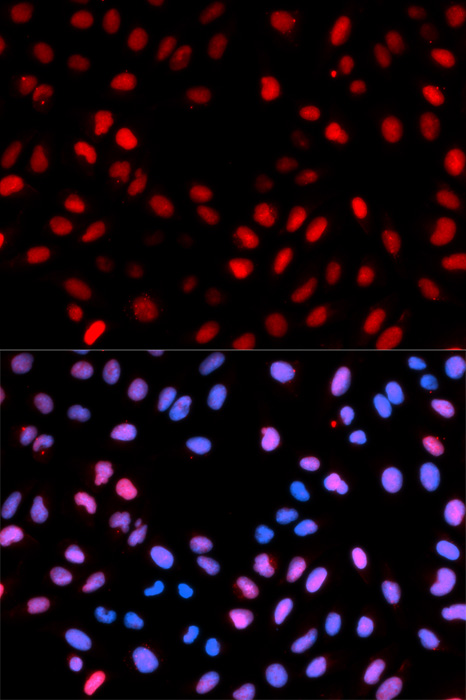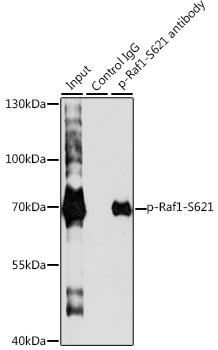Cell Biology Antibodies 16
Anti-Phospho-RAF1-S621 Antibody (CABP0087)
- SKU:
- CABP0087
- Product Type:
- Antibody
- Applications:
- WB
- Applications:
- IF
- Applications:
- IP
- Reactivity:
- Human
- Host Species:
- Rabbit
- Isotype:
- IgG
- Research Area:
- Cell Biology
Description
| Antibody Name: | Anti-Phospho-RAF1-S621 Antibody |
| Antibody SKU: | CABP0087 |
| Antibody Size: | 20uL, 50uL, 100uL |
| Application: | WB IF IP |
| Reactivity: | Human |
| Host Species: | Rabbit |
| Immunogen: | A synthetic phosphorylated peptide around S621 of human Raf1 (NP_002871.1). |
| Application: | WB IF IP |
| Recommended Dilution: | WB 1:500 - 1:2000 IF 1:50 - 1:200 IP 1:50 - 1:100 |
| Reactivity: | Human |
| Positive Samples: | HeLa, 293T |
| Immunogen: | A synthetic phosphorylated peptide around S621 of human Raf1 (NP_002871.1). |
| Purification Method: | Affinity purification |
| Storage Buffer: | Store at -20°C. Avoid freeze / thaw cycles. Buffer: PBS with 0.02% sodium azide, 50% glycerol, pH7.3. |
| Isotype: | IgG |
| Sequence: | SASE P |
| Gene ID: | 5894 |
| Uniprot: | P04049 |
| Cellular Location: | Cell membrane, Cytoplasm, Mitochondrion, Nucleus |
| Calculated MW: | 73kDa/75kDa |
| Observed MW: | 73kDa |
| Synonyms: | CMD1NN, CRAF, NS5, Raf-1, c-Raf, RAF1 |
| Background: | This gene is the cellular homolog of viral raf gene (v-raf). The encoded protein is a MAP kinase kinase kinase (MAP3K), which functions downstream of the Ras family of membrane associated GTPases to which it binds directly. Once activated, the cellular RAF1 protein can phosphorylate to activate the dual specificity protein kinases MEK1 and MEK2, which in turn phosphorylate to activate the serine/threonine specific protein kinases, ERK1 and ERK2. Activated ERKs are pleiotropic effectors of cell physiology and play an important role in the control of gene expression involved in the cell division cycle, apoptosis, cell differentiation and cell migration. Mutations in this gene are associated with Noonan syndrome 5 and LEOPARD syndrome 2. |
| UniProt Protein Function: | RAF1: a proto-oncogenic TKL kinase of the RAF family. Functions downstream of the Ras family of membrane associated GTPases to which it binds directly. Once activated Raf-1 can phosphorylate and activate MEK1/2, which in turn phosphorylate and activate ERK1/2. Acts as a regulatory link between the membrane-associated Ras GTPases and the MAPK/ERK cascade, and this critical regulatory link functions as a switch determining cell fate decisions including proliferation, differentiation, apoptosis, survival and oncogenic transformation. RAF1 activation initiates a mitogen-activated protein kinase (MAPK) cascade that comprises a sequential phosphorylation of the dual-specific MAPK kinases (MEK1/2) and the extracellular signal-regulated kinases (ERK1/2). RAF1, subsequent to phosphorylation by PAK1, phosphorylates BAD (Bcl2-antagonist of cell death) at S75. Phosphorylates adenylyl cyclases ADCY2, ADCY5 and ADCY6, resulting in their activation. Phosphorylates PPP1R12A resulting in inhibition of the phosphatase activity. Phosphorylates TNNT2 (cardiac muscle troponin T). Can promote NF-kB activation and inhibit signal transducers involved in motility (ROCK2), apoptosis (ASK1 and MST2), proliferation and angiogenesis (RB1). Can protect cells from apoptosis also by translocating to the mitochondria where it binds BCL2 and displaces BAD. Restricts caspase activation in response to selected stimuli, notably Fas stimulation, pathogen-mediated macrophage apoptosis, and erythroid differentiation. |
| UniProt Protein Details: | Protein type:EC 2.7.11.1; Protein kinase, Ser/Thr (non-receptor); Oncoprotein; Kinase, protein; Protein kinase, TKL; TKL group; RAF family Chromosomal Location of Human Ortholog: 3p25 Cellular Component: Golgi apparatus; mitochondrial outer membrane; cytoplasm; plasma membrane; pseudopodium; nucleus; cytosol Molecular Function:small GTPase binding; protein serine/threonine kinase activity; identical protein binding; protein binding; MAP kinase kinase kinase activity; mitogen-activated protein kinase kinase binding; protein heterodimerization activity; metal ion binding; ATP binding; protein kinase activity Biological Process: axon guidance; nerve growth factor receptor signaling pathway; activation of MAPKK activity; wound healing; apoptosis; somatic stem cell maintenance; heart development; intermediate filament cytoskeleton organization and biogenesis; negative regulation of caspase activity; signal transduction; protein amino acid phosphorylation; regulation of apoptosis; negative regulation of cell proliferation; synaptic transmission; small GTPase mediated signal transduction; regulation of cell differentiation; transmembrane transport; epidermal growth factor receptor signaling pathway; platelet activation; fibroblast growth factor receptor signaling pathway; adenylate cyclase activation; MAPKKK cascade; positive regulation of peptidyl-serine phosphorylation; cell proliferation; Ras protein signal transduction; response to hypoxia; regulation of Rho protein signal transduction; insulin receptor signaling pathway; innate immune response; vascular endothelial growth factor receptor signaling pathway; blood coagulation; negative regulation of protein complex assembly; negative regulation of apoptosis Disease: Cardiomyopathy, Dilated, 1nn; Noonan Syndrome 5; Leopard Syndrome 2 |
| NCBI Summary: | This gene is the cellular homolog of viral raf gene (v-raf). The encoded protein is a MAP kinase kinase kinase (MAP3K), which functions downstream of the Ras family of membrane associated GTPases to which it binds directly. Once activated, the cellular RAF1 protein can phosphorylate to activate the dual specificity protein kinases MEK1 and MEK2, which in turn phosphorylate to activate the serine/threonine specific protein kinases, ERK1 and ERK2. Activated ERKs are pleiotropic effectors of cell physiology and play an important role in the control of gene expression involved in the cell division cycle, apoptosis, cell differentiation and cell migration. Mutations in this gene are associated with Noonan syndrome 5 and LEOPARD syndrome 2. [provided by RefSeq, Jul 2008] |
| UniProt Code: | P04049 |
| NCBI GenInfo Identifier: | 125651 |
| NCBI Gene ID: | 5894 |
| NCBI Accession: | P04049.1 |
| UniProt Secondary Accession: | P04049,Q15278, Q9UC20, B0LPH8, B2R5N3, |
| UniProt Related Accession: | P04049 |
| Molecular Weight: | 648 |
| NCBI Full Name: | RAF proto-oncogene serine/threonine-protein kinase |
| NCBI Synonym Full Names: | Raf-1 proto-oncogene, serine/threonine kinase |
| NCBI Official Symbol: | RAF1 |
| NCBI Official Synonym Symbols: | NS5; CRAF; Raf-1; c-Raf; CMD1NN |
| NCBI Protein Information: | RAF proto-oncogene serine/threonine-protein kinase; Oncogene RAF1; proto-oncogene c-RAF; C-Raf proto-oncogene, serine/threonine kinase; v-raf-1 murine leukemia viral oncogene homolog 1; raf proto-oncogene serine/threonine protein kinase |
| UniProt Protein Name: | RAF proto-oncogene serine/threonine-protein kinase |
| UniProt Synonym Protein Names: | Proto-oncogene c-RAF; cRaf; Raf-1 |
| Protein Family: | Rik1-associated factor |
| UniProt Gene Name: | RAF1 |
| UniProt Entry Name: | RAF1_HUMAN |









